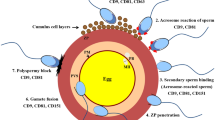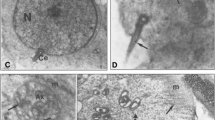Abstract
Extracellular ATP and its hydrolysis product adenosine modulate various reproductive functions such as those requiring contraction, steroidogenesis, and maintenance of fluid composition. Interestingly, adenosine might act as a key capacitative effector for mammalian spermatozoa to acquire the capacity for fertilisation. Extracellular nucleotide levels are affected by cell surface ectonucleotidases, amongst which the ectonucleoside triphosphate diphosphohydrolase (E-NTPDase) family regroups the most abundant and effective enzymes to hydrolyse ATP and ADP to AMP in physiological conditions. In the male reproductive tract three members of this family have been indentified: NTPDase1, NTPDase2 and NTPDase3 (Martín-Satué et al. in Histochem Cell Biol 131:615–628, 2009). The purpose of the present study was to characterize in the male reproductive tract the expression profile of the main enzyme responsible for the generation of adenosine from AMP, namely the ecto-5′-nucleotidase (CD73). The enzyme was identified by immunological techniques and by in situ enzymatic assays, including inhibition experiments with α,β-methylene-ADP, a specific CD73 inhibitor. High levels of ecto-5′-nucleotidase were detected in testes in association with both germinal and somatic cells, in smooth muscle cells throughout the tract, in secretory epithelia from exocrine glands, and remarkably, in principal cells of epididymis, where co-localization with NTPDase3 was found. The relevance of this co-expression on nucleotide hydrolysis in these cells directly involved in the control of sperm fluid composition was addressed biochemically. This study suggests close regulation of extracellular nucleoside and nucleotide levels in the genital tract by ecto-5′-nucleotidase that, in concurrence with NTPDases, may impact male fertility.






Similar content being viewed by others
References
Adeoya-Osiguwa SA, Fraser LR (2002) Capacitation state-dependent changes in adenosine receptors and their regulation of adenylyl cyclase/cAMP. Mol Reprod Dev 63(2):245–255
Aliagas E, Torrejón-Escribano B, Lavoie EG, de Aranda IG, Sévigny J, Solsona C, Martín-Satué M (2010) Changes in expression and activity levels of ecto-5′-nucleotidase/CD73 along the mouse female estrous cycle. Acta Physiol (Oxf) Feb 5. doi:10.1111/j.1748-1716.2010.02095.x (Epub ahead of print)
Antonio LS, Costa RR, Gomes MD, Varanda WA (2009) Mouse Leydig cells express multiple P2X receptor subunits. Purinergic Signal 3:277–287
Banks FC, Calvert RC, Burnstock G (2009) Changing P2X receptor localization on maturing sperm in the epididymides of mice, hamsters, rats, and humans: a preliminary study. Fertil and Steril. doi:10.1016/j.fertnstert.2009.02.061
Baykov AA, Evtushenko OA, Avaeva SM (1988) A malachite green procedure for orthophosphate determination and its use in alkaline phosphatase-based enzyme immunoassay. Anal Biochem 171:266–270
Belleannee C, Da Silva N, Shum W, Breton S (2009) Role of luminal ATP and adenosine in V-ATPase activation. Biol Reprod 81:21
Benarroch EE (2008) Adenosine and its receptors: multiple modulatory functions and potential therapeutic targets for neurologic disease. Neurology 70:231–236
Boeynaems JM, Communi D, Gonzalez NS, Robaye B (2005) Overview of the P2 receptors. Semin Thromb Hemost 31:139–149
Braun N, Sévigny J, Mishra SK, Robson SC, Barth SW, Gerstberger R, Hammer K, Zimmermann H (2003) Expression of the ecto-ATPase NTPDase2 in the germinal zones of the developing and adult rat brain. Eur J Neurosci 17:1355–1364
Burnstock G (2006) Purinergic signalling. Br J Pharmacol 147(Suppl 1):S172–S181
Burnstock G (2007) Physiology and pathophysiology of purinergic neurotransmission. Physiol Rev 87:659–797
Carlin RW, Lee JH, Marcus DC, Schultz BD (2003) Adenosine stimulates anion secretion across cultured and native adult human vas deferens epithelia. Biol Reprod 68:1027–1034
Colgan SP, Eltzschig HK, Eckle T, Thompson LF (2006) Physiological roles for ecto-5′-nucleotidase (CD73). Purinergic Signal 2(2):351–360
Diniz C, Leal S, Goncalves J (2003) Regional differences in the adenosine A(2) receptor-mediated modulation of contractions in rat vas deferens. Eur J Pharmacol 460:191–199
Fausther M, Lecka J, Kukulski F, Lévesque SA, Pelletier J, Zimmermann H, Dranoff JA, Sévigny J (2007) Cloning, purification, and identification of the liver canalicular ecto-ATPase as NTPDase8. Am J Physiol Gastrointest Liver Physiol 292:G785–G795
Foresta C, Rossato M, Di Virgilio F (1992) Extracellular ATP is a trigger for the acrosome reaction in human spermatozoa. J Biol Chem 267(27):19443–19447
Foresta C, Rossato M, Nogara A, Gottardello F, Bordon P, Di Virgilio F (1996) Role of P2-purinergic receptors in rat Leydig cell steroidogenesis. Biochem J 320:499–504
Fraser LR (2008) The role of small molecules in sperm capacitation. Theriogenology 70:1356–1359
Fredholm BB, Jzerman AP, Jacobson KA, Klotz KN, Linden J (2001) International Union of Pharmacology XXV nomenclature and classification of adenosine receptors. Pharmacol Rev 53:527–552
Glass R, Bardini M, Robson T, Burnstock G (2001) Expression of nucleotide P2X receptor subtypes during spermatogenesis in the adult rat testis. Cells Tissues Organs 169(4):377–387
Kauffenstein G, Drouin A, Thorin-Trescases N, Bachelard H, Robaye B, D’Orléans-Juste P, Marceau F, Thorin E, Sévigny J (2010) NTPDase1 (CD39) controls nucleotide-dependent vasoconstriction in mouse. Cardiovasc Res 1;85(1):204–213
Koszalka P, Ozüyaman B, Huo Y, Zernecke A, Flögel U, Braun N, Buchheiser A, Decking UK, Smith ML, Sévigny J, Gear A, Weber AA, Molojavyi A, Ding Z, Weber C, Ley K, Zimmermann H, Gödecke A, Schrader J (2004) Targeted disruption of cd73/ecto-5′-nucleotidase alters thromboregulation and augments vascular inflammatory response. Circ Res 95(8):814–821
Kukulski F, Lévesque SA, Lavoie EG, Lecka J, Bigonnesse F, Knowles AF, Robson SC, Kirley TL, Sévigny J (2005) Comparative hydrolysis of P2 receptor agonists by NTPDases 1, 2, 3 and 8. Purinergic Signal 1:193–204
Laemmli UK (1970) Cleavage of structural proteins during the assembly of the head of bacteriophage T4. Nature 227:680–685
Lazarowski ER, Tarran R, Grubb BR, van Heusden CA, Okada S, Boucher RC (2004) Nucleotide release provides a mechanism for airway surface liquid homeostasis. J Biol Chem 279(35):36855–36864
Levitt B, Head RJ, Westfall DP (1984) High-pressure liquid chromatographic-fluorometric detection of adenosine and adenine nucleotides: application to endogenous content and electrically induced release of adenyl purines in guinea pig vas deferens. Anal Biochem 137(1):93–100
Loir M (2001) Adenosine receptor-adenylate cyclase system in the trout testis: involvement in the regulation of germ cell proliferation. Mol Reprod Dev 58(3):307–317
Martín-Satué M, Lavoie EG, Pelletier J, Fausther M, Csizmadia E, Guckelberger O, Robson SC, Sévigny J (2009) Localization of plasma membrane bound NTPDases in the murine reproductive tract. Histochem Cell Biol 131:615–628
Minelli A, Allegrucci C, Piomboni P, Mannucci R, Lluis C, Franco R (2000) Immunolocalization of A1 adenosine receptors in mammalian spermatozoa. J Histochem Cytochem 48:1163–1171
Minelli A, Liguori L, Bellazza I, Mannucci R, Johansson B, Fredholm BB (2004) Involvement of A1 adenosine receptors in the acquisition of fertilizing capacity. J Androl 25:286–292
Minelli A, Bellezza I, Collodel G, Fredholm BB (2008) Promiscuous coupling and involvement of protein kinase C and extracellular signal-regulated kinase 1/2 in the adenosine A1 receptor signalling in mammalian spermatozoa. Biochem Pharmacol 75:931–941
Monks NJ, Fraser LR (1988) Enzymes of adenosine metabolism in mouse sperm suspensions. J Reprod Fertil 83:389–399
Queiroz G, Talaia C, Goncalves J (2003a) ATP modulates noradrenaline release by activation of inhibitory P2Y receptors and facilitatory P2X receptors in the rat vas deferens. J Pharmacol Exp Ther 307:809–815
Queiroz G, Talaia C, Gonçalves J (2003b) Adenosine A2A receptor-mediated facilitation of noradrenaline release involves protein kinase C activation and attenuation of presynaptic inhibitory receptor-mediated effects in the rat vas deferens. J Neurochem 85(3):740–748
Resta R, Hooker SW, Hansen KR, Laurent AB, Park JL, Blackburn MR, Knudsen TB, Thompson LF (1993) Murine ecto-5′-nucleotidase (CD73): cDNA cloning and tissue distribution. Gene 133(2):171–177
Rivkees SA (1994) Localization and characterization of adenosine receptor expression in rat testis. Endocrinology 135:2307–2313
Robson SC, Sévigny J, Zimmermann H (2006) The E-NTPDase family of ectonucleotidases: structure function relationships and pathophysiological significance. Purinergic Signal 2:409–430
Rodriguez-Miranda E, Buffone MG, Edwards SE, Ord TS, Lin K, Sammel MD, Gerton GL, Moss SB, Williams CJ (2008) Extracellular adenosine 5′-triphosphate alters motility and improves the fertilizing capability of mouse sperm. Biol Reprod 79:164–171
Schuh SM, Hille B, Babcock DF (2007) Adenosine and catecholamine agonists speed the flagellar beat of mammalian sperm by a non-receptor-mediated mechanism. Biol Reprod 77:960–969
Yegutkin GG (2008) Nucleotide- and nucleoside-converting ectoenzymes: important modulators of purinergic signalling cascade. Biochim Biophys Acta 1783:673–694
Zhou WL, Zuo WL, Ruan YC, Wang Z, Du JY, Xiong Y, Chan HC (2007) The role of extracellular ATP in the male reproductive tract. Sheng Li Xue Bao 59:487–494
Zimmermann H (2001) Ectonucleotidases: some recent developments and a note on nomenclature. Drug Dev Res 52:44–56
Acknowledgements
This work was supported by grants to J. Sévigny from the Canadian Institutes of Health Research (CIHR) and to M. Martín-Satué from the University of Barcelona (ACESB09). M. Martín-Satué was recipient of a fellowship from the Spanish Ministry of Education and Science (MEC-Programa José Castillejo), E.G. Lavoie of a scholarship from the Fonds de Recherche en Santé du Québec (FRSQ) and J. Sévigny of a New Investigator award from the CIHR and of a Junior 2 scholarship from the FRSQ. Authors thank Benjamín Torrejón-Escribano from the Microscopy Unit of Serveis Cientificotècnics of the University of Barcelona (Bellvitge Campus) for his technical assistance. MF was a recipient of a scholarship from the government of Gabon.
Author information
Authors and Affiliations
Corresponding authors
Additional information
M. Martín-Satué and E. G. Lavoie contributed equally to the work.
Electronic supplementary material
Below is the link to the electronic supplementary material.
418_2010_704_MOESM1_ESM.jpeg
Supplementary Figure 1. Immunofluorescence (A) and western blot (B) of ecto-5’-nucleotidase in mouse sperm. A) Ecto-5’-nucleotidase was not detected in sperm smears (a). DAPI was used to label the nuclei (b). Scale bar 20 μm. B) Ecto-5’-nucleotidase was detected in total sperm homogenate and in the soluble fraction but not in spermatozoa alone. Five μg of particulate membrane protein fraction of epididymis were used as control for the presence of the protein (JPEG 64 kb)
418_2010_704_MOESM2_ESM.jpeg
Supplementary Figure 2. Immunolocalization of ecto-5’-nucleotidase in mouse epididymis. Ecto-5’-nucleotidase was detected by immunofluorescence at the luminal surface of principal cells from epithelium in caput (A), corpus (B) and cauda (C) epididymis. Scale bar 75 μm. (JPEG 110 kb)
Rights and permissions
About this article
Cite this article
Martín-Satué, M., Lavoie, E.G., Fausther, M. et al. High expression and activity of ecto-5′-nucleotidase/CD73 in the male murine reproductive tract. Histochem Cell Biol 133, 659–668 (2010). https://doi.org/10.1007/s00418-010-0704-z
Accepted:
Published:
Issue Date:
DOI: https://doi.org/10.1007/s00418-010-0704-z




